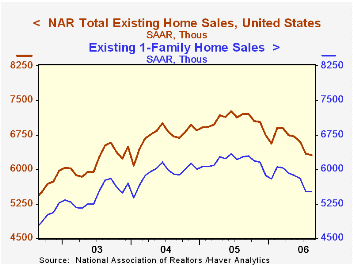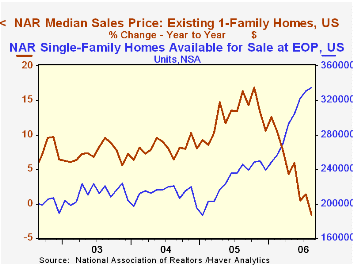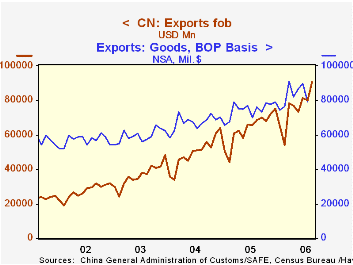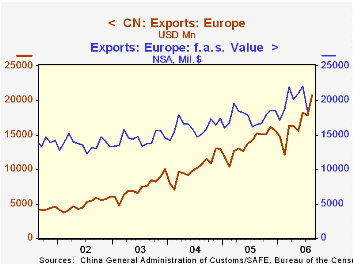 Global| Sep 25 2006
Global| Sep 25 2006U.S. Existing Home Sales Hold Up As Prices Fell
by:Tom Moeller
|in:Economy in Brief
Summary
Total existing home sales fell just 0.5% during August to 6.30M according to the National Association of Realtors, and it was the sixth decline this year. Though it lowered sales 13.3% below the peak in June of 2005, the decline [...]

 The inventory of unsold existing homes rose another 1.5% (37.9% y/y). The supply of unsold single family homes rose 1.2% (36.2% y/y) and the supply of condos & coops for sale rose 3.1% m/m (49.1% y/y).
The latest release from the National Association of Realtors is available here.
The inventory of unsold existing homes rose another 1.5% (37.9% y/y). The supply of unsold single family homes rose 1.2% (36.2% y/y) and the supply of condos & coops for sale rose 3.1% m/m (49.1% y/y).
The latest release from the National Association of Realtors is available here.
Slowdown in housing won't shut down economic growth from the Federal Reserve Bank of St. Louis can be found here.
Residential mortgage default from the Federal Reserve Bank of Philadelphia is available here.
| Existing Home Sales (000, AR) | August | July | Y/Y | 2005 | 2004 | 2003 |
|---|---|---|---|---|---|---|
| Total Home Sales | 6,300 | 6,330 | -12.6% | 7,064 | 6,722 | 6,176 |
| Single Family Home Sales | 5,510 | 5,510 | -12.3% | 6,170 | 5,912 | 5,443 |
| Single Family Median Home Price (000) | $225.7 | $230.9 | -1.7% | $217.5 | $192.8 | $178.3 |
by Louise Curley September 25, 2006

China's total exports in July at $80.3 billion exceeded the seasonally unadjusted exports of the United States at $79.2 billion for the first time. US data for August has not yet been published, but Chinese exports in August took another jump to reach $90.7 billion. As the first chart shows, the growth in China's exports suggests that it will not be long before China becomes the world's biggest exporter, ousting the United States from its long standing position.
In all the major geographic areas, Chinese exports are growing faster than those of the US. As an example, the second chart compares China and US exports to Europe. Even in areas where the US is still a dominant supplier, such as Latin America, the year to year growth in China's export to that region has greatly exceeded that of the US, as shown in the third chart.
China's status as the Number One Exporter in the world is not without its problems. As a result of the large current account surplus that has resulted from China's fast growing exports and slow growing imports, China's international reserves are close to $1.0 trillion. The management of the reserves has become increasingly burdensome and risky. And China's reluctance to appreciate its currency is becoming increasingly under attack.
| Exports (Billions USD) | Aug 06 | Jul 06 | Jul 06 |
|---|---|---|---|
| China | China | US | |
| Total | 90.7 | 80.3 | 79.2 |
| To Europe | 20.7 | 17.8 | 18.4 |
| To Latin America | 3.6 | 3.1 | 16.9 |
Tom Moeller
AuthorMore in Author Profile »Prior to joining Haver Analytics in 2000, Mr. Moeller worked as the Economist at Chancellor Capital Management from 1985 to 1999. There, he developed comprehensive economic forecasts and interpreted economic data for equity and fixed income portfolio managers. Also at Chancellor, Mr. Moeller worked as an equity analyst and was responsible for researching and rating companies in the economically sensitive automobile and housing industries for investment in Chancellor’s equity portfolio. Prior to joining Chancellor, Mr. Moeller was an Economist at Citibank from 1979 to 1984. He also analyzed pricing behavior in the metals industry for the Council on Wage and Price Stability in Washington, D.C. In 1999, Mr. Moeller received the award for most accurate forecast from the Forecasters' Club of New York. From 1990 to 1992 he was President of the New York Association for Business Economists. Mr. Moeller earned an M.B.A. in Finance from Fordham University, where he graduated in 1987. He holds a Bachelor of Arts in Economics from George Washington University.






